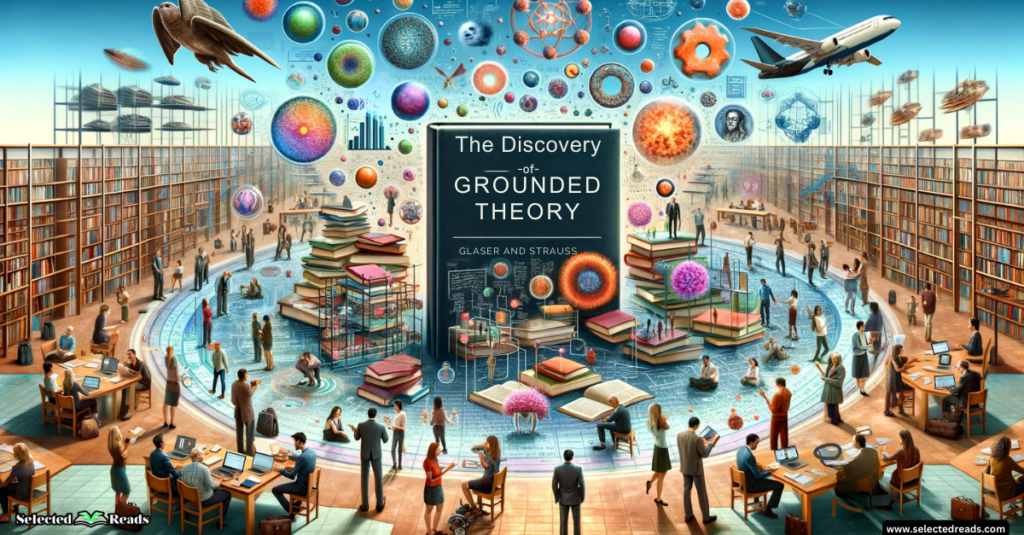Grounded theory can be a tough nut to crack. I know it because I’ve been there. During my doctoral studies, I remember sitting in seminars scratching my head as we delved into various research methodologies. I wasn’t the only one; several of my colleagues were equally stumped when it came to really grasping the essence of grounded theory.
It wasn’t until I rolled up my sleeves and dug into the seminal work on the subject that things started to click. If you’re feeling the same way, struggling to get a handle on this elusive concept, I’ve got a lifeline for you: Go straight to the source and read “The Discovery of Grounded Theory: Strategies for Qualitative Research” by Barney G. Glaser and Anselm L. Strauss.
First published in 1967, this foundational text has gone through various editions but remains the go-to guide for understanding grounded theory. Charmz even underlines how it serves as a powerful statement, encapsulating the original ideas that shaped this research methodology.
After reading the book multiple times and grappling with its key elements, I thought I’d break down some of its core ideas to help demystify this concept for you. Let’s walk through what grounded theory is, its key elements, and how to integrate it into your own research practice.
Now, don’t get me wrong—this post isn’t a substitute for reading the actual book. But consider it a friendly nudge, a primer to help you get started on a deeper understanding of grounded theory.
So, whether you’re a grad student trying to decipher your course readings or an educational researcher like me looking to refine your methodology, let’s jump in and unravel the complexities of grounded theory.
What is Grounded theory according to Glaser and Strauss?
According to Glaser and Strauss (1967), the overarching goal of grounded theory is to discover theory from data, rather than testing theory. They state:
Most writing on sociological method has been concerned with how accurate facts can be obtained and how theory can thereby be more rigorously tested. In this book we address ourselves to the equally important enterprise of how the discovery of theory from data—systematically obtained and analyzed in social research—can be furthered. We believe that the discovery of theory from data—which we call grounded theory—is a major task confronting sociology today, for, as we shall try to show, such a theory fits empirical situations, and is understandable to sociologists and layman alike. (p. 1)
So right off the bat, we’re shifting away from the idea of gathering data to fit preconceived theories. Instead, we’re letting the data speak for itself.
The authors go on to contrast grounded theory with traditional methods, stating, “Our basic position is that generating grounded theory is a way of arriving at theory suited to its supposed uses. We shall contrast this position with theory generated by logical deduction from a priori assumptions” (p. 3).
The takeaway here is the shift in focus from deducing theories based on assumptions to actually generating theories grounded in data.
What I find compelling is the authors’ emphasis on theory as a process rather than a finished product. They note:
Generating a theory from data means that most hypotheses and concepts not only come from the data, but are systematically worked out in relation to the data during the course of the research. Generating a theory involves a process of research. (p. 6)
They further added that “grounded theory can be presented either as a well codified set of propositions or in a running theoretical discussion, using conceptual categories and their properties (p 31). This underscores the flexibility and fluidity inherent in grounded theory; it allows for an evolving understanding of the phenomena being studied.
They further describe theory as an “ever-developing entity,” stating, “our strategy of comparative analysis for generating theory puts a high emphasis on theory as process; that is, theory as an ever-developing entity, not as a perfected product” (p. 32).
In essence, Glaser and Strauss shift the paradigm from theory as a rigid, static entity to a dynamic, data-driven process. They also emphasize that that the purpose of research is not only to verify existing theories but to also generate new theories and conceptions. This approach not only honors the complexities of social phenomena but also resonates with those of us who see research as an ever-evolving journey.
Grounded Theory Versus Logico-Deductive Approach
In their foundational book “The Discovery of Grounded Theory“, Glaser and Strauss (1967) delineate the key differences between grounded theory and the logico-deductive approach in the development of sociological theories.
They critique what they term “exampling,” where a researcher selects instances that merely confirm a preconceived, speculative, or logically deduced theory, giving the illusion of proof without genuine empirical validation.
They argue that while some researchers claim to allow examples to inform their theories, in practice, this middle ground between grounded and logico-deductive theory often remains murky.
Unlike these approaches, grounded theory is data-driven from the get-go. It is generated inductively from the research itself and uses examples solely to illustrate or clarify the theory, not to give it unearned detail.
This grounded approach, they argue, yields theories that are not only more reliable but also more usable and relevant. Glaser and Strauss emphasize that the validity and usefulness of a theory are intricately linked to the methods by which it was generated.
The usual standards for evaluating theory—like logical consistency, clarity, and parsimony—are also influenced by how the theory came to be, challenging the notion held by some logico-deductive theorists that these criteria are independent of the theory’s genesis.
What is the role of theory in research?
According to Glaser and Strauss (1967), the interrelated jobs of theory in sociology are:
(1) to enable prediction and explanation of behavior;
(2) to be useful in theoretical advance in sociology;
(3) to be usable in practical applications—prediction and explanation should be able
to give the practitioner understanding and some control of situations;
(4) to provide a perspective on behavior—a stance tobe taken toward data; and
(5) to guide and provide a style for research on particular areas of behavior. (p.3)
In “The Discovery of Grounded Theory“, Glaser and Strauss offer a multifaceted view on the role of theory in sociology, breaking it down into several interconnected tasks. First off, they argue that theory should facilitate the prediction and explanation of behavior.
It’s not just about identifying patterns but being able to foresee how they’ll manifest in various scenarios. The goal isn’t purely academic; it also has a pragmatic angle, aiming to arm practitioners with understanding and a level of control over situations.
Second, a robust theory should contribute to theoretical advancement in the broader field of sociology. In a way, it should be a building block for future theories, research, and academic discourse. This reminds me of how we often look for edtech tools that not only solve a current problem but also can be scalable or adaptable for future challenges in education.
Third, a theory should offer a unique perspective or lens through which to view data. It should guide the research process, influencing how data is collected, analyzed, and interpreted. This is somewhat analogous to how we choose different edtech tools based on our teaching philosophies and the specific learning outcomes we aim for.
Fourth, they emphasize the clarity and operationalizability of the theory. It should be framed in such a way that it can be easily tested and verified in both current and future studies. This is particularly important for quantitative research, where empirical validation is crucial.
Lastly, a theory should be universally comprehensible, catering not just to scholars but also to students and the layperson.
In essence, Glaser and Strauss see theory as a tool for handling data, offering modes of conceptualization for describing and explaining phenomena. For them, the theory has to “fit” and “work,” meaning it should naturally align with the data and prove effective in explaining the behavior in focus.
You can see how this aligns with various perspectives in educational research as well. A solid theory doesn’t just stand in isolation; it should be a functional tool that aids in understanding and improving real-world scenarios.
Substantive Versus Formal Theories
in their seminal text “The Discovery of Grounded Theory“, Glaser and Strauss (1967) discuss two types of theories that can be generated through comparative analysis: substantive and formal theory.
Substantive theory, as they explained, is focused on specific empirical areas within sociology like patient care, race relations, or delinquency. It’s about the nitty-gritty details of particular social contexts.
Formal theory, on the other hand, zooms out to tackle broader conceptual areas like stigma, authority, or social mobility. Both types fall into what’s termed “middle-range,” existing somewhere between minor, everyday hypotheses and grand, all-encompassing theories.
The key difference between the two types of theories lies in their level of generality; substantive theories are more specific, while formal theories are more abstract. However, they can overlap, and a single study, as Glaser and Strauss confirm, could touch on both, although the researchers should be clear about their primary focus because the strategies for developing each type differ.
Here is an illustrative example by the authors: if you’re studying the substantive area of dying, you might compare different hospital wards. But if you’re looking at formal theory, you might compare different types of status passage, like dying, studenthood, or engagement, to generate a broader theory on the concept of status passage itself.
According to Glaser and Strauss (1967):
“Both substantive and formal theories must be grounded in data. Substantive theory faithful to the empirical situation cannot, we believe, be formulated merely by applying a few ideas from an established formal theory to the substantive area. To be sure one goes out and studies an area with a particular sociological perspective, and with a focus, a general question, or a problem in mind. But he can ( and we believe should) also study an area without any preconceived theory that dictates, prior to the research, “relevancies” in concepts and hypotheses.” (pp. 5-10)
An important point highlighted by Glaser and Strauss here is that both substantive and formal theories need to be rooted in real-world data, rather than preconceived notions or existing theoretical frameworks.
They caution against the temptation to apply established formal theories directly to a specific substantive area. Doing so, they argue, can lead to a “forcing of data” and a neglect of potentially relevant concepts that might naturally emerge from the data.
Instead, they advocate for a more open approach, letting substantive theories emerge naturally from the data first. This initial, data-driven substantive theory can then inform which existing formal theories might be applicable, allowing for a more authentic and unbiased analysis.
They also highlight that substantive theory isn’t just an end in itself but can be a stepping stone to generating or refining formal theories. For example, by studying “awareness contexts” in different settings like healthcare and espionage, they’re able to develop a more generalized formal theory about awareness, stakes, and cues. This reflects their larger belief that theories should be grounded in empirical data rather than abstract speculations or “oughts.”
What are The Elements of Theory?
According to Glaser and Strauss (1967), the essential elements of theory consist of conceptual categories, their properties, and hypotheses that describe relationships among these categories and properties.
- Conceptual Categories and Properties: A category is a standalone conceptual element within a theory, while a property is a facet or aspect of that category. For instance,the authors illustrated, in nursing care, the category could be “professional composure,” and a related property could be the nurse’s “perception of social loss” in a dying patient. These aren’t just academic abstractions; they should be informed directly by empirical data.
- Hypotheses: These are generalized relations among the categories and their properties. The hypotheses, according to Glazer and Strauss, emerge quickly as you compare different groups, offering suggested relations that should later be verified in ongoing research. So, in the context of nursing care, a hypothesis might point to how “loss rationales” (a property of social loss) help nurses maintain their professional composure.
- Integration: This is the process of combining categories, properties, and hypotheses into a cohesive, unified framework. And just like categories and hypotheses, the framework should emerge from the data. It’s a living, evolving thing, capable of accommodating new categories or properties as they arise.
Glaser and Strauss also reiterate their take regarding the risk of ‘forcing’ data to fit preconceived theoretical frameworks. Instead, they recommend initially ignoring existing literature and theories to let categories and relationships emerge naturally. This helps in avoiding contamination of emerging categories with ideas that might be more relevant to other areas.
Conclusion
Grounded theory as conceptualized by Strauss and Glaser in their book, The Discovery of Grounded Theory, is an analytic process that comprises data collection, coding, and analysis. Strauss and Glaser place outsized importance on synchronizing data collection, coding, and analysis in the process of generating theory. They argue that these three elements should not be distinct steps but should be continually interwoven throughout the research process.
Traditional methods often separate these operations, but doing so can hamper theory development. If you’re too focused on just one aspect, say coding, and a new analytical insight pops up, it may be ignored because it doesn’t fit within the established procedures, thus impeding the theory’s evolution.
So, the key takeaway here from Strauss and Glaser is to keep the process of theory generation dynamic, with data collection, coding, and analysis seamlessly interlinked from start to finish. This approach ensures a more organic and robust theory that is truly grounded in the data.






